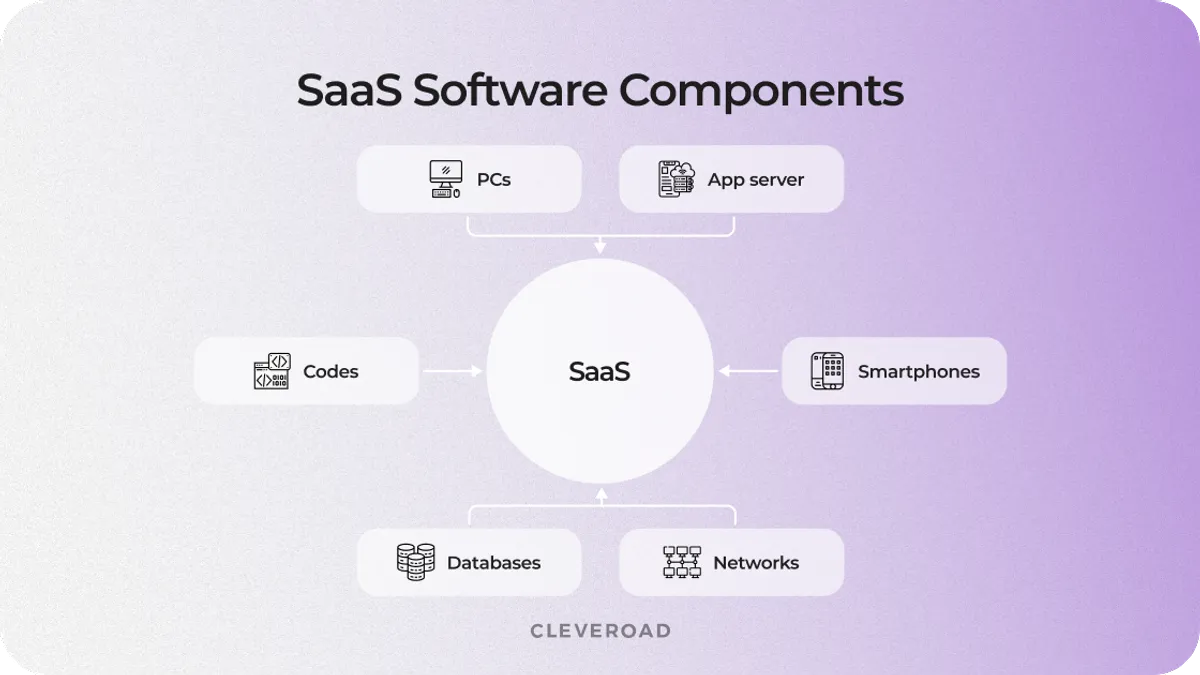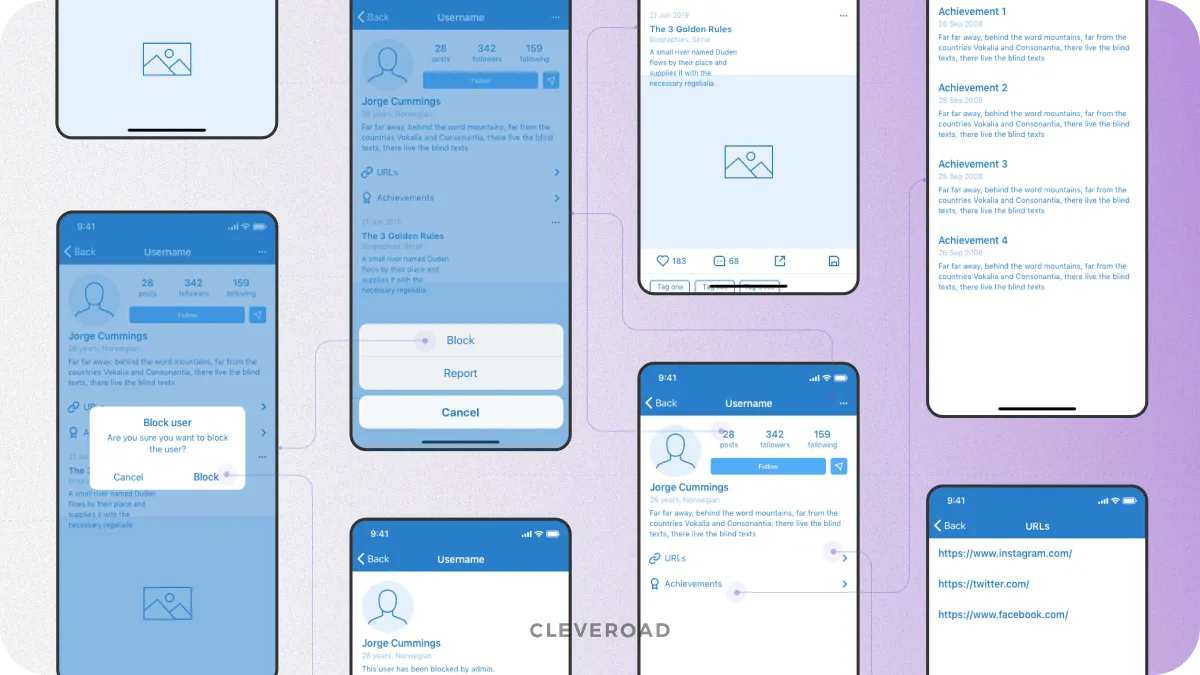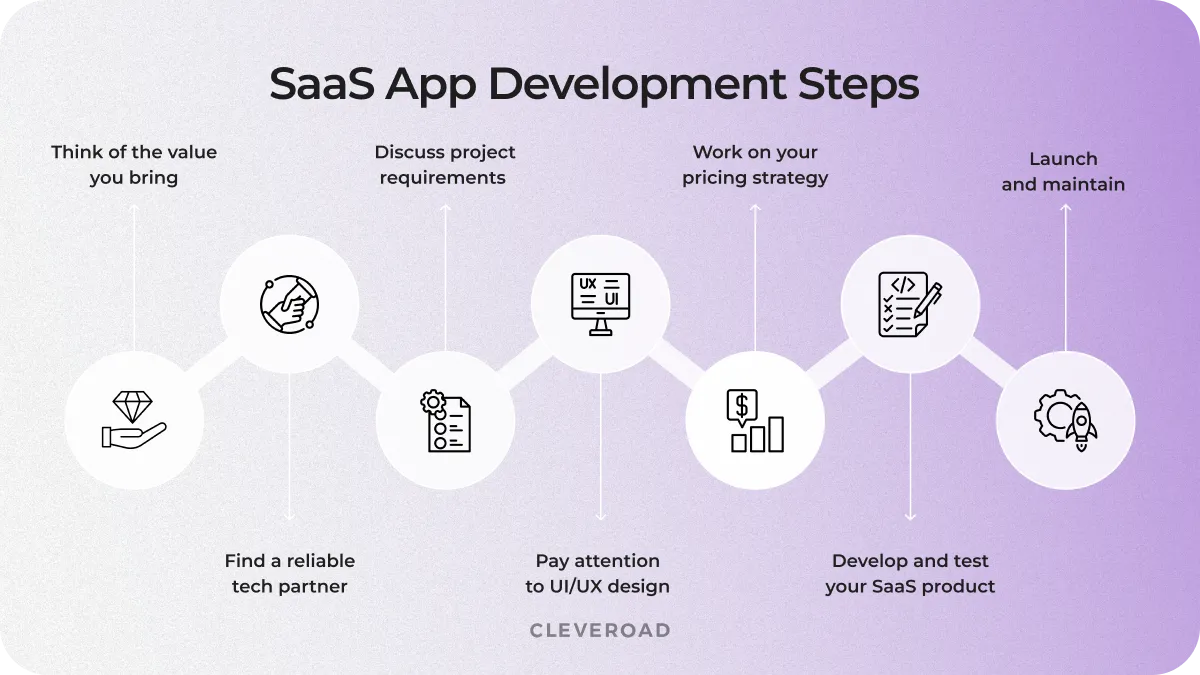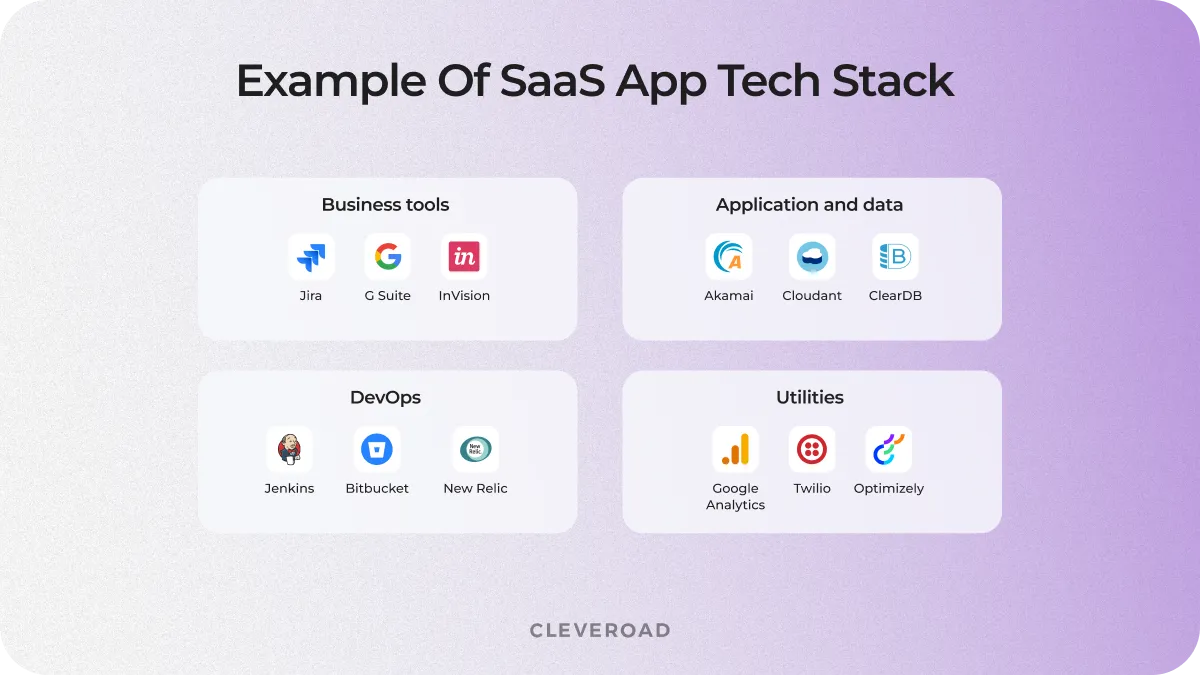The Full Guide on SaaS Development
Updated 08 Jan 2025
20 Min
4862 Views
Software as a Service (SaaS) is advancing by leaps and bounds, offering companies a new approach to creating software. With it, users pay only for services applied, gaining long-term, easily predictable profit. Thus, building SaaS application can help you with business expansion, and the modern market already has excellent solutions developed with this model. G Suite, Slack, Salesforce, and other SaaS solutions bring a bunch of digital changes to businesses of all kinds.
But why is SaaS cloud application development popular among businesses and service providers? How to build a SaaS app? How much does it cost to develop a SaaS platform? In this article, we’ll dive into all the details of building SaaS applications.
What Is SaaS Application Development
SaaS app development is an approach to building an application that is accessible over the Internet on a subscription-based model. In contrast with the traditional model, the apps are placed in remote cloud storage and are available via the web or an API. SaaS applications are also known as web-based software, on-demand software, or hosted software. Regardless of what we call it, such products are stored on providers’ servers. The vendor controls the access to the software, incorporating protection, availability, and operation. It is the main difference between building SaaS apps and traditional ones.
After releasing a SaaS app, developers continue to work on it constantly. It’s required to update the service regularly to gain more users and stand up to the competition.
There are a bunch of SaaS products on the market, from office software (GSuite) to messengers for work (Slack). What’s more, enterprises like Amazon, Salesforce, and Box have development teams to keep their solutions up to date.

SaaS software components
Types of SaaS software
We can classify SaaS applications into different types based on the industry they serve. Here are some examples of such types:
- Customer Relationship Management (CRM) systems, such as Salesforce, manage customer data and operations and are ideal for eCommerce businesses in both B2B and B2C segments.
- Enterprise Resource Planning (ERP) systems supplied via the SaaS business model allow corporations to pay as they go (PAYG) and customize features based on current business needs.
- Billing and accounting SaaS applications deliver flexible subscription packages that companies can tailor to their size, number of employees, customers, and partners.
- Project administration and teamwork tools like Jira, ClickUp, and Monday are commonly delivered as SaaS applications.
- Collaboration instruments, such as Slack, offer different subscription plans depending on team size and scalability.
SaaS development market overview
Software as a Service is becoming more and more popular in the world, and this is confirmed by IT market statistics. Over two decades of evolution have propelled the global SaaS market to a valuation of billions of dollars, and statistics prove it.
According to MADX, the SaaS market has seen an average annual growth rate of 25% over the last decade. Furthermore, its growth remains relentless, with projections indicating the market will surpass $1 trillion by 2032. In turn, Statista said that the compound annual revenue growth rate (CAGR) from 2025 to 2029 will be 19.38%, and the market size will reach $793.10 billion by the end of 2029.
Based on this data, it is sure to say that SaaS app development is a promising area for businesses.
Advantages of SaaS Development
SaaS solution development has a high potential for improving your business. We have singled out its main advantages:
Cost efficiency
SaaS development lets businesses be free of purchasing and maintaining expensive hardware. Unlike a common model, SaaS apps are located in the cloud environment at a lower price for hardware and software licenses. It’s common for SaaS app development costs to contain to offer paid subscriptions. So, the company pays for the required functionality and can discontinue paid subscriptions if the business doesn’t need the service.
Scalability
Ordinarily, SaaS software is placed in scalable cloud environments that can integrate third parties for SaaS products. The main peculiarity of this model lies in the fact that it doesn’t require purchasing another server or software. Due to the subscription, businesses can only pay for the services they need. If requirements change, it’s convenient to upgrade the subscription plan with a few clicks.
Reliability
SaaS application development uncovers the opportunity for stability while unforeseen circumstances arise because such solutions are cloud-based. A cloud is a network of services that can be placed anywhere globally. In case of one server failure, SaaS products still work. Thus, software with such high stability will remain working. It lets your company get an advantage over the other competitors on the market who do not use SaaS services.
Security
Any cloud service provider tends to consider security issues. They make considerable investments to ensure high-quality services with the highest protection. As a result, all the information is well-protected and is stored in a safe place. However, in some cases, cloud providers can't meet all the company's security needs. Thus, it's essential to monitor cloud security risks and their ways of eliminating them.
Learn more about cloud security risks and how SaaS solutions can deal with them
No hardware and maintenance
As mentioned before, a great advantage of SaaS applications is no need for huge spending on hardware and its setting up configuration and local software operation. Apart from this, enterprises don’t have to cope with app maintenance, support, and licenses. Instead, SaaS companies provide all the processing so companies can concentrate on business. After the subscription approval, the app is launched and can be run.
Accessibility
The cross-platform characteristic stipulates the fact that SaaS application development provides running via the browser, which is obviously available on every modern gadget. It makes all the data accessible in different locations, whether your customers use a desktop or smartphone, out of the house, or in. Thanks to it, such apps are more convenient in our quickly-changed tech world.
Wide range of providers
Business owners are able to select from a great diversity of SaaS vendors and switch between them to find the one that fulfills their needs the most. Enterprises have a cancellation plan for SaaS subscriptions in case the quality of the services doesn’t meet their requirements or they don’t need them. In practice, the switching process comprises certain complexities, yet it’s still possible.
Easy integration
APIs expand the functionality of SaaS software by integrating third-party systems with it. As a result, by covering more customers' needs, software as a service development lets you attract a bigger audience because clients enjoy it when all the features they need are in one place, in one app. Furthermore, companies can integrate their own systems with SaaS vendors. The modern market of SaaS vendors is full of those that ensure enhanced integrations with other systems.
How to Start a Complete SaaS Application Development From Scratch
How do you start a complete SaaS app development? We’ve singled out the six steps to building a SaaS product. Let’s consider each step more closely.
Step 1. Think of the value you bring
To gain users for your SaaS product, you need to offer a solid and valuable solution. Customers want to understand the value of the product before subscribing and paying for it. For example, it’s a good idea to offer a free trial period for a certain period of time. In this case, customers can appreciate the use and efficiency that your SaaS service brings them. Also, you can offer to pay for a single use of the platform. It’ll be convenient for users who don’t use the service a lot.
To complete this phase better, we also recommend you answer the following questions:
- Will your product align with the aims and targets of your business?
- Do you already have the experts and resources required to do this, or will you also need to engage a development team?
- How does this project fit in with your company's other initiatives?
- How much will the project set you back? What is the optimal pricing strategy?
Also, building a SaaS application requires knowing the market and understanding your target audience. It’s good to analyze competitors, the features of their solutions and business models. Thanks to it, you can realize how to make your SaaS solution stand out from the existing products.
Step 3. Find a tech partner
During the following stages, you should find and cooperate with a solid tech vendor. It is vital to fulfill the SaaS implementation hand in hand with an experienced IT partner, as you are able to delegate the tech side of the project to a team of competent experts. Here is some advice on how to make a wise choice and what to pay attention to:
- The company's expertise and experience. Research how experienced the SaaS application development company is in your industry, what technology it uses, and what services it provides.
- Portfolios and cases. Review the provider's portfolio and examine the cases of projects they've worked on. This will help you assess the company's level of expertise and background.
- Quality and support. Make sure that the provider provides a high-quality product and is ready to provide proper support in case of any arising tech challenges.
- Client reviews. Customer experience from collaboration with IT vendors is a good source. To learn more about our expertise, check out our portfolio and look through our profile on Clutch.
Cleveroad software engineers are experienced in working with cloud services and have been providing custom software development services for years. From our practice, we’ve developed and implemented a SaaS-based Quality Management System (QMS) for a US-based medical device company. It’s a fully-fledged B2B SaaS solution built from scratch that aims to reduce manual operations and free up labor. The new system allowed the organization to optimize prices on B2B SaaS usage for end clients and enhance competitiveness.
Here is what Breanne Butler, Project Manager at Prime Path Medtech™, says about cooperation with Cleveroad in creating a SaaS QMS solution.
Breanne Butler, Project manager at Prime Path Medtech™. Feedback about cooperation with Cleveroad
Step 3. Discuss project requirements
The requirements discussion stage takes place in two phases. The first stage is the Solution Design Stage. In this stage, we connect your business objectives with technical implementation. Our team actively explores your needs, listens to your challenges, and proposes solutions that meet your goals. We have a dedicated solution team of certified business analysts, experienced solution architects, and creative designers who can help you achieve this. Their job is to understand your business processes, formulate functional requirements, and propose the optimal technical architecture. At Cleveroad, we provide a free Solution Design Workshop.
The second phase is the Discovery Phase. During the Discovery Phase, we turn the collected requirements into a clear action plan. This allows us to speed up development and improve product quality. The team clarifies your business processes, analyzes the previously collected requirements, and goes into detail - platforms, features, and third-party services for integration.
At Discovery Phase, we:
- Compile a detailed list of features
- Analyze business processes and create visualizations
- Analyze quality attributes
- Create a design concept and UX map
- Prepare a detailed estimate with a timeline and team composition
Step 4. Pay attention to UI/UX design
After drawing up a list of required features, it’s time to turn to UI/UX design services, an essential part of developing SaaS applications. Users are quite spoiled these days. They tend to abandon web apps and sites with unattractive and unclear designs. So, to make a SaaS app profitable, you need to create a SaaS application from scratch with a user-friendly design, thinking how it will look in the web browser or the in-app. Design creation requires time and investment. Everything starts with wireframes. They stand for a layout of elements on the app screen. Wireframes tend to be monochrome and show the screen's connection.

Illustration of wireframes for SaaS applications designed by Cleveroad
AfAfter creating wireframes, designers create a visual style for your future app. They pick the appropriate colors, fonts, and other graphic elements. The next, it’s time to create a design. Designers create all the app screens and their conditions. After that, they make a clickable prototype. The last step of the UI/UX design process is handing over the design to SaaS application developers.
Step 5. Work on your pricing strategy
The pricing strategy for custom SaaS app development is vital. For example, it’s common to offer a subscription plan. You should create several plans according to the user's needs and expectations. Additionally, it’s good if your SaaS application developer adds several free functions or implements a free trial period. This stage requires the entrepreneur to determine the system he will create, how it will vary from rivals, his target market, and his price strategy and marketing mix. He might pick from the following SaaS pricing options:
- Price-plus-cost. This pricing strategy, often known as cost-based pricing, is one of the most common, especially for startups. With this SaaS model, you sell your goods for more than it costs you to produce them to turn a profit.
- Pricing depends on value. With the help of this pricing method, you can match the cost of your SaaS product to the benefits it offers users. Instead of just estimating the costs, you should conduct research on your target market to understand their needs.
- Pricing based on competitors. Using this pricing strategy, you may determine your product's price based on the pricing of your rivals without having to do in-depth market research or estimate your costs of doing business.
Step 6. Develop and test your SaaS product
It’s high time to proceed to the process of the SaaS software development, features implementation, and building scalable software architecture with high robustness. At this stage, the SaaS development team must create clean and maintainable code and provide flexibility and responsiveness to changes in requirements. The product should be tested at each stage and before launching. This phase should be included as obligatory as it determines the SaaS app performance by helping to detect software bugs.
Another essential step of development is the in-app operations required compliance. They should meet the agreements, protection, compliance, and infrastructure requirements of the cloud services. It should comply with specifications as well as with covered methods of service deployment.
Step 7. Launch and maintain
SaaS application launch is the process of bringing software to market so that users can start using it. It includes final product preparation, setting up the infrastructure, testing on a limited audience, and official opening to the general public. After successfully launching a product, it is important to maintain it. Even if the product runs smoothly, support is still necessary. Maintenance includes not only solving problems and fixing unforeseen situations but also regular updates, adding new features, customization, and improvements. Proper maintenance ensures the stability and performance of the application and improves the user experience, which in turn increases customer satisfaction and contributes to the success of the product.

Steps to Develop a SaaS Application
Tech Challenges You May Face Within the SaaS Development Process
SaaS app development can be challenging due to many technical difficulties. Let’s talk about the main things to consider before you start creating your solution.
Techstack selection
One of the most complicated challenges you will face during the SaaS app development flow is choosing a solution stack to apply for this goal. It may be complicated to define the one with the help of which all functionality elements will meet your requirements, especially if you lack a tech background.
Yet, it’s essential to come up with the technologies to use as they determine how the app will fulfill the set tasks correctly. To overcome this issue and not fail, it’s better to apply to specialists who will assemble the necessary solutions specifically for your case. To give you a hint on how to develop a SaaS application, we’ve assembled the Salesforce tech stack below:

Example of a techstack for a SaaS solution used by Salesforce
Platform scalability
Let’s face it: You’re wondering how to start a complete SaaS application development successfully, so you need to choose a scalable tech stack. A complex solution has to be customizable at each layer.
As a result, developers should consider the following aspects:
- Interface
- Integrations
- Feature-list
- Page templates
- URL structure
You should remember that an unscalable solution stack simply makes it impossible to expand and advance your business. It might become an issue for companies (due to poor performance with the growing number of customers and, accordingly, workload) and clients (who won’t be able to use the solution in case of application failure and inability to cope with a higher workload).
In turn, scalable products will let you attract users and bring value in the long run. We at Cleveroad, as AWS’s select tier partner, can develop a scalable cloud product for you.
Confidentiality and privacy
SaaS solutions often work with business segments and process/keep a lot of sensitive information. As a SaaS product development vendor, you need to guarantee data privacy to your users. Such information as bank data, personal data, and customer information may leak due to a lack of security. It’ll lead to losing your customers and their trust. Additionally, you can pay an enormous fine. Before accessing such data to external systems, you should verify the credibility and solidity of the service. Furthermore, access management and identity should be primarily handled as well. You should take strict measures before any confidential data is available for a service vendor.
SaaS app development should essentially foresee compliance with a Privacy Policy and a SaaS app Terms of Use/Terms and Conditions agreement for your app. Both of those guidelines comprise individual aims. Within the law, the first act is not obligatory yet but is highly recommended. It serves as a legally binding contract between you and your customers.
Hardware robustness
The app runs on physical servers located in a specific region, and if they get damaged (fire, water, explosion, etc.), it may lead to a failure. In terms of credibility, the AWS platform is beneficial, as it stores the hardware regularly and cares about data security and backups. It also excludes the overload and failure of your SaaS architecture. Besides, you can upgrade your plan in case your business requires an expanded amount of resources for SaaS application development. Beyond just using AWS, our team of AWS-certified tech experts can help you design, optimize, and maintain solutions tailored to your business needs. Whether scaling resources, improving security, or providing seamless performance, we at Cleveroad will help you with it.
Integrations
Every SaaS-based app development requires a bunch of third-party integrations like Google Maps, PayPal, and others. As discussed previously, any additional features included in SaaS-based application development require third-party integration. Let’s look at some of them:
- Customer Relationship Management (CRM) systems. Custom CRM development integration will effectively manage customer interactions and data.
- Marketing automation tools. Integration with services such as Mailchimp or Marketo will streamline marketing campaigns and lead management.
- Accounting and finance software. Financial software is needed not only to know how to build a fintech app but also to create a SaaS solution so it helps with accounting.
- Project management tools. Combine with platforms such as Asana or Trello to enhance project tracking and collaboration.
- Communication platforms. Integration with tools like Slack or Microsoft Teams will improve team communication and coordination.
When applying third parties to a product, SaaS vendors host a row of software solutions, and difficulties might appear in integrating services into the already built-in-house application. There’s a possibility that data structures and APIs won’t correctly respond to external services. To prevent this obstacle, you should check if the chosen third-party services are compatible with your product’s structure.
How Much Does It Cost to Build a SaaS Platform?
After considering the process and pitfalls of developing a SaaS application, let’s calculate their final price. The final SaaS application development cost varies on the following factors:
- Hiring option
- The team’s hourly rates
- The complexity of features
Hiring options for SaaS app development
Before diving deeper into the existing hiring options you can choose from, let’s primarily define the standard team structure to develop a SaaS application. It usually comprises the following specialists:
- Project Manager
- Business Analyst
- UX/UI designer
- Backend developer
- Frontend developer
- QA engineer
Two popular options for employing software engineers are creating an in-house team and finding a reliable outsourcing vendor.
The in-house model provides creating your own development team, which can be quite profitable if you’ve already released the product to the market and made some profit. For example, several investors are interested in your solution, and you need to improve the app. However, this hiring option tends to be expensive due to a bunch of additional expenses like office rent, hardware, software, taxes, and so on. That’s why it fits best to established companies that need to extend their team. Besides, you should look for specialists competent in developing SaaS applications yourself.
Outsourcing is gaining popularity due to affordable hourly rates, talented developers, and the high quality of the final product. There are many offshore software development companies all over the world, so you can hire SaaS app developers from anywhere for your project. The primary benefit of SaaS is cost flexibility. By outsourcing, companies can often reduce expenses as they don’t have to invest in hiring full-time employees or maintaining an in-house team.
Another key advantage is faster project delivery. Outsourcing firms typically have established processes and experienced teams that can hit the ground running. Moreover, outsourcing opens access to huge talent pools. Companies are no longer restricted to their region and can hire developers they want despite their location.
Check out our article comparing in-house vs. outsourcing software development to find out which option suits you.
Hourly rates
Developers usually have an hourly rate. They can vary according to these factors:
- Hiring options (in-house teams or outsourcing companies)
- Qualification (junior, middle, senior) and region of the world
For example, outsourced developers have lower hourly rates than engineers from an in-house team. Moreover, the region is also significant. Developers from the USA have higher rates than developers from Central and Eastern Europe. Junior mobile app development programmers have lower hourly rates than their senior colleagues. Below, you can see the developers’ rates in various regions:
| Region | Developers' rates ($ per h) |
North America | $150-$200 |
Western Europe | $50-$149 |
Eastern Europe | $25-$49 |
Oceania | $100-$150 |
Asia | $20-$40 |
South America | $25-$49 |
The estimated numbers are created for your orientation and are approximate. Please note that you can always optimize your expenditures with no quality loss by applying to a reliable software development vendor from a popular outsourcing region.
The complexity of features
How do you calculate the price of building a SaaS application? You need to multiply the time needed for development by the developers’ rates. The development time depends on the features’ complexity. The more complicated the feature is, the more time developers need to implement it in the product. Let’s consider Slack as an example. To create an app like Slack (SaaS MVP development version), you need at least 2632 hours.
You can study the details below.
| SaaS creation work type | Approximate time (h) |
iOS development | 852 hours |
Android development | 852 hours |
Back-end development | 768 hours |
UI/UX design (for one platform) | 80 hours |
Total hours | 2632 hours |
We’ve estimated the approximate cost of making an app like Slack for iOS and Android in different regions of the world:
- Eastern Europe. $131,600 (based on $50/h)
- North America. $263,200 (based on $100/h)
- Western Europe. $236,880 (based on $90/h)
- Australia. $263,880 (based on $90/h)
If you want to know the exact price of your SaaS product, contact us, and our team of experts will help you. We will give you an accurate cost estimation based on your unique case.
Cleveroad Expertise in SaaS Development
Cleveroad is a software development company with headquarters in EU, Estonia, with 13+ years of experience. We have been delivering excellent IT services, including custom software development, SaaS app creation, cloud development, IT consulting, legacy software modernization, etc. We help companies advance workflow efficiency, help overcome business-related challenges, and provide other competitive advantages.
By cooperating with Cleveroad, you’ll be ensured a wide range of benefits, including:
- A high level of expertise in providing cloud services, which is assured by Amazon Web Services (AWS) Select Tier Partner status within the AWS Partner Network (APN).
- A team of experts with practical experience in working with cloud-based services (AWS, Azure, Google Cloud, and others)
- Free Solution Workshop stage to align your business requirements with technical implementation. Our tech experts will understand your goals and needs and customize IT solutions to match your project's objectives and requirements.
- Three flexible cooperation models: dedicated team, IT staff augmentation, and project-based.
- Partnership with an ISO-certified company implementing ISO 9001 quality management systems and ISO 27001 security standards.
- Proven solid experience in software development across numerous industries, like FinTech, Healthcare, Media, Retail, Education, Marketplaces, etc.
The Cleveroad team is competent in Saas web application development, as well as mobile one, integrating APIs, qualitative data storage, and cloud hosting. Our professionals apply all our resources to guarantee meeting each of your requirements and architect a full-fledged SaaS application.
To demonstrate our expertise in SaaS app development, we would like to present one of our recent projects called RetailOps:
RetailOps is a versatile SaaS platform for retail operations, including warehouse management, inventory control, receiving, and more. We started redesigning the app to make it more easy-to-use. We’ve re-engineered RetailOps and made it run on Swift (the native language used for iOS development) instead of Cordova. The application is integrated with the Socket Mobile barcode scanner utilizing its SDK. That means an iPhone can connect with the scanner via Bluetooth. The app helps track every movement of inventory from the moment it arrives in a warehouse to the minute it ships.
Here’s what Daniel Norman, CTO of RetailOps, says about working with Cleveroad.


Create a SaaS app for your business!
Our team, with 13+ years of experience in cloud development, is ready to help you. Contact us to get assistance in creating top-quality SaaS software for you
SaaS app development is an approach to creating an application that is accessible over the internet on a subscription-based model. SaaS apps are also known as web-based software, on-demand software, or hosted software.
There are seven steps of SaaS app development:
- Step 1. Think of the value you bring
- Step 2. Find a tech partner
- Step 3. Discuss project requirements
- Step 4. Pay attention to UI/UX design
- Step 5. Work on your pricing strategy
- Step 6. Develop and test your SaaS product
- Step 7. Launch and maintain
Software as a Service (SaaS) is advancing by leaps and bounds, offering companies a new approach to creating software. With it, users pay only for services applied, gaining long-term, easily predictable profit.
The SaaS approach to applications involves hosting software in the cloud, which is accessible to users through a subscription model. This eliminates the need for businesses to purchase, install, and maintain expensive hardware and software. Instead, SaaS providers handle updates, maintenance, and scalability, ensuring users only pay for the features they need. It offers flexibility, lower upfront costs, and easier scalability compared to traditional software models.
The main difference between software development and SaaS (Software as a Service) is how the software is delivered and maintained. With traditional software development, businesses must purchase and maintain expensive hardware and software licenses. In contrast, SaaS apps are hosted in the cloud, eliminating the need for businesses to invest in costly infrastructure. SaaS solutions typically offer paid subscriptions, allowing companies to pay only for the features they need and discontinue the service when it's no longer required.

Evgeniy Altynpara is a CTO and member of the Forbes Councils’ community of tech professionals. He is an expert in software development and technological entrepreneurship and has 10+years of experience in digital transformation consulting in Healthcare, FinTech, Supply Chain and Logistics
Give us your impressions about this article
Give us your impressions about this article
Comments
8 commentsThanks for the post, nice information about saas application development… it is really helpful. I will recommend these blogs to others.
Thanks for sharing a good article,it solved my current needs.
Thanks for this in-depth SaaS Guidance. As per the market competition, I feel SaaS App development is best for being an industry leader.
Hello! I found this article very useful. It is interesting to know how Cleveroad is helps make SaaS solutions for various industries. I think that SaaS apps are profitable for e-commerce and retail.
Thanks for the valuable information you shared with us
Thanks for sharing
I want to make a SaaS solution for e-commerce business. I like the piece of information you shared with us. The text is useful and easy-to-read for beginners and startupers.
Nice text)